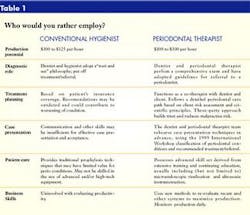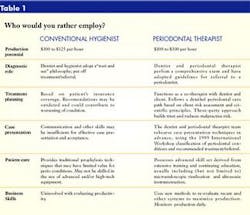THINK OUTSIDE THE BOX
by Lynne Hollister Slim, RDH, BSDH, MSDH
I once asked my vivacious, energetic, 83-year-old grandmother how she could be as full of life as an 18-year-old. She replied, "Whenever you lose your flexibility, you are truly old." By that standard, I have observed many "old" people who are in their 20s, 30s and 40s. They lack the flexibility and commitment to make the changes that can make their lives more efficient and productive.
Many dental hygiene departments are similarly resistant to change and merely break even or eke out a minimal profit. Practices may have neglected to evaluate their hygiene operations for years. Practice-management consultants repeatedly urge dentists to maximize dental hygiene to increase profits and improve care, yet a majority of practices struggle to accept and apply this new standard of periodontal care.
Anticipating change prepares us for success. The entire gamut of dental hygiene services is changing, signaling exciting opportunities for general practices. We must abandon outdated services and roles for conventional dental hygienists and adopt 21st-century business models.
Hygiene students spend many hours mastering the art of traditional prophylaxis. The conventional hygienist performs a credible service by deplaquing bacterial biofilm during prophylaxis. In spite of its advantages as a routine recare procedure, the traditional prophy is only appropriate for children and adults who have a healthy periodontium. Comprehensive periodontal examination, diagnosis, treatment planning, and referral to a periodontist are the foundation of successful periodontal therapy. However, important professional intervention is noticeably missing in many general dental practices, leading to increased malpractice exposure. Clients' gingival and periodontal diseases often remain undiagnosed because the periodontal examination is missing from the new-patient and recare client protocol. Just as a nurse would not treat a deep splinter wound by cleaning it and then bandaging it, a conventional dental hygienist who is trained as a periodontal therapist would not perform a recare prophylaxis on adult clients with inflammatory gingival or periodontal diseases.
Consider an example of a typical adult recare appointment that did not serve the needs of a particular client.
Scenario No. 1
Mark, an adult recare client and tennis pro, presents for a traditional prophylaxis. He is fully compliant with his six-month recare visits. When the hygienist performs a PSR exam, she detects 4 to 5 millimeter probing depths, generalized and heavy bleeding on probing, marked gingival inflammation of the maxillary and mandibular anterior teeth, light subgingival calculus in areas of inflammation, and moderate to heavy plaque biofilm. The hygienist cannot adequately scale subgingivally because of the client's discomfort. After polishing with a rubber cup, the dentist performs a routine exam. Noticing the pronounced inflammation, the dentist recommends that Mark make an appointment for a six-month recare visit. The hygienist recommends that Mark floss daily, brush thoroughly, and suggests that his condition will be re-evaluated in six-months.
What is wrong with the care these clinicians rendered? Was Mark's condition adequately addressed? He may have left the dental office that day feeling content; however, both the dentist and the hygienist performed a disservice by failing to adequately diagnose and recommend treatment for a specific type of periodontal disease. Mark left the office with an untreated infection, high levels of subgingival bacteria, and a microflora incompatible with oral health. How could he have been treated differently? Let's take a different look.
Scenario No. 2
The hygienist gives Mark a hand mirror and shows him the bleeding and inflammation. She then questions Mark closely and discovers that he is having marital problems in addition to dissatisfaction with his employment. He admits that his home care has slipped significantly in the last few months. Based on the hygienist's preliminary findings, she performs a comprehensive periodontal exam. She then confers privately with the dentist about the client's condition. The dentist confirms the hygienist's findings, recommends a full-mouth series of periapical radiographs, and explains to Mark that a "cleaning" isn't the appropriate way to treat the periodontal infection. Because the client experienced tremendous discomfort during probing, the dentist recommends four quadrants of scaling and root planing with local anesthesia in addition to detailed home care. He further advises the client to return for a four to six-week re-evaluation, followed by three-month recare intervals until Mark's periodontium is healthy. The hygienist spends the remainder of the appointment educating Mark about his infection, and she takes the appropriate radiographs.
In this scenario, Mark leaves the operatory fully informed about his condition, appreciative of his dentist and hygienist's abilities, and ready to schedule the recommended scaling and root planing appointments.
When a client presents with a condition similar to Mark's, a "cleaning" visit would have been inappropriate and even detrimental. In determining a client's recare interval, the client's oral hygiene level, periodontal disease history, and systemic health must be considered. How do we go about changing dental hygiene terminology and stretching our boundaries? How can we think outside the traditional prophylaxis box?
The answer comes in three parts and each one is equally important to a successful outcome:
• Educating your dental team
• Incorporating nonsurgical periodontal therapy into your daily practice
• Evaluating your results
Educating your dental team — The real challenge is to define your business in terms of results. For example, if your team determines that a healthy periodontium for all clients is a valuable goal, then gather everyonearound the table and figure out how to accomplish it. "Unlearn" what dental hygiene services have been provided in the past and relearn based on client needs.
Teach your staff about subgingival recolonization of bacteria. Invite a local periodontist to talk about the subgingival microflora that are associated with periodontal diseases and how the microflora change over time. Explain that the goal of treatment is to change a client's microflora from one that is destructive to one that is more compatible with health. Get excited about the idea of routine subgingival bacterial disinfection during the hygiene recare appointment, and try to motivate your staff and clients to a higher level of education about periodontal disease classifications. Once you educate your clients, you will discover that they will no longer be content with a 30-to-40-minute traditional prophylaxis. Savvy, well-educated consumers will expect an adult prophylaxis or other recommended treatment that is compatible with periodontal health.
An excellent way to involve your dental hygienist(s) in meeting your new practice goal is to include your referring periodontist in your plans. Your hygiene team and that of your referring periodontist can meet and discuss alternating recare compliance, along with many other aspects of nonsurgical periodontal therapy. The issue of when to refer the client to a periodontist is an important one, and the referring periodontist can assist you in developing guidelines for referral.
Incorporating nonsurgical periodontal therapy into your daily practice — On the desk of a prominent innovative executive is the admonition, "Lead, follow, or get out of the way." While this style may work for some businesses, it often leaves unnecessary carnage in a dental practice. A comprehensive periodontal plan requires active and enthusiastic participation from the entire staff. Quality, nonsurgical periodontal therapy is essential for professional excellence, credibility, and client retention, but requires advanced training on the part of the dental hygienist.
The periodontal therapist is the lead clinician who executes and monitors the periodontal care plan under the supervision of the dentist. This position should be filled by a conventional dental hygienist who incorporates nonsurgical periodontal therapy into daily practice. Competence requires the periodontal therapist to possess a thorough understanding of responsible client management.
Not all dental hygienists are created equally. Advances in therapy have significantly changed the dental hygienist's treatment modalities. The quality of patient care is greatly dependent on the hygienist's professional training, continuing education, and motivation.
Periodontal therapy also requires a caring approach to manage client anxiety, promote wellness, and reduce pain. The periodontal therapist must possess a thorough understanding of the "whole" client by assessing both physical and psychological needs and apply scientific rationale to treatment planning.
Evaluating your results —To generate additional revenue in the dental hygiene division, you must set a higher standard of periodontal and other preventive care. Appropriate examination and treatment-planning procedures will generate an ideal mix of clients. With careful and deliberate scheduling, you can create a win-win situation for the practice, the client, and therapist.
Inspiring your staff and your clients to achieve periodontal health will promote client and staff loyalty. Ignoring your clients' periodontal diseases, especially those present at an early stage, is a disservice to both your clients and staff. Look at your clients and staff as your customers and nurture them. Don't neglect the periodontium, and make certain that the client's total health and well being are your most important daily focus. Practice success is sure to follow this charted path and you will find that you will not have to place an emphasis on production to achieve your financial goals. Client-centered periodontal therapy will bring financial rewards and, more importantly, contented clients and staff.

